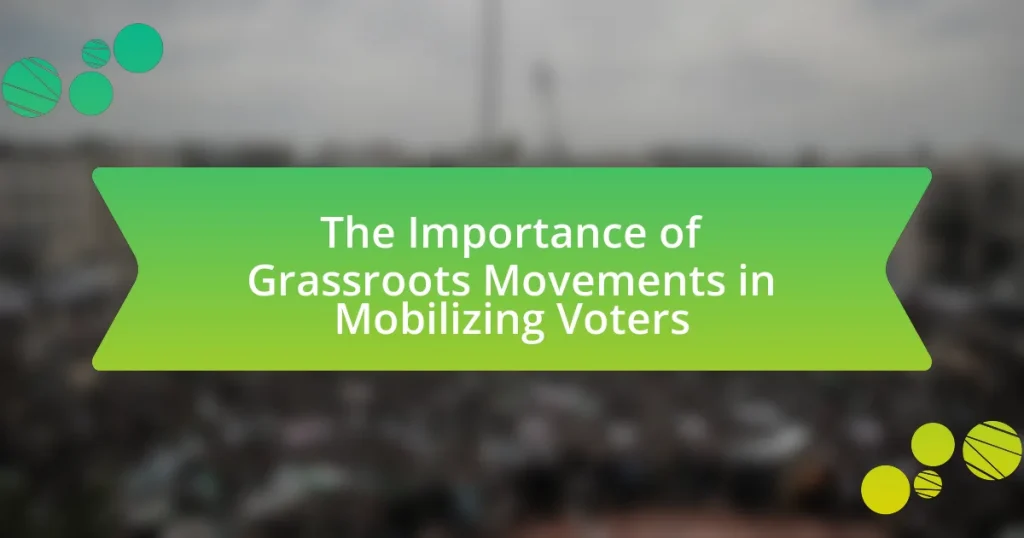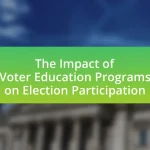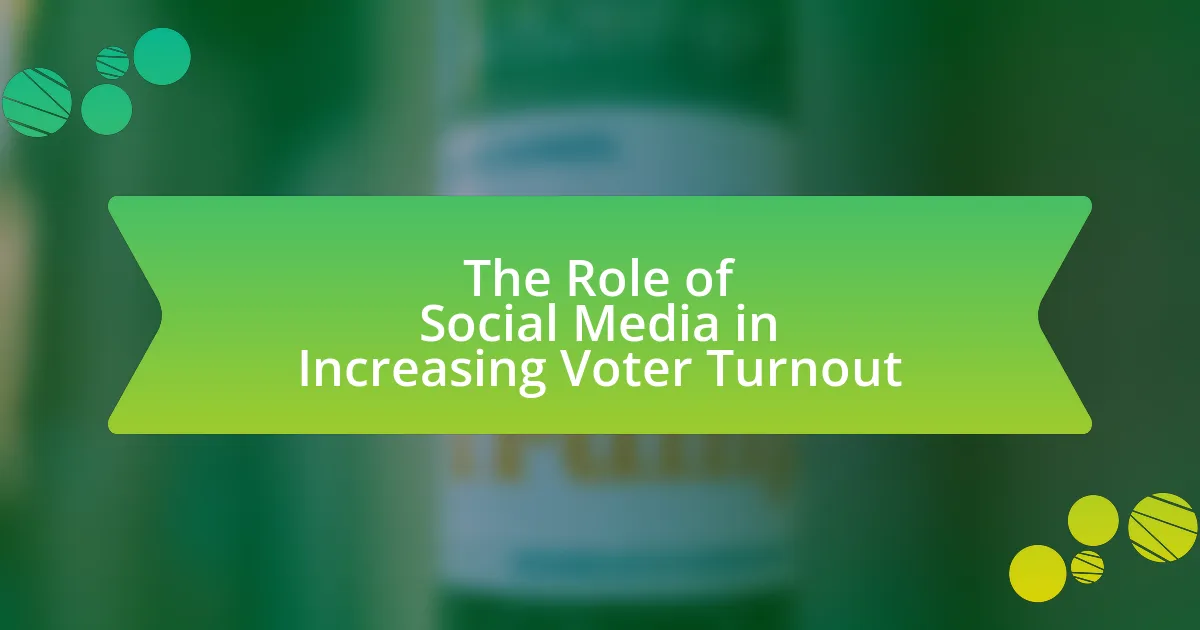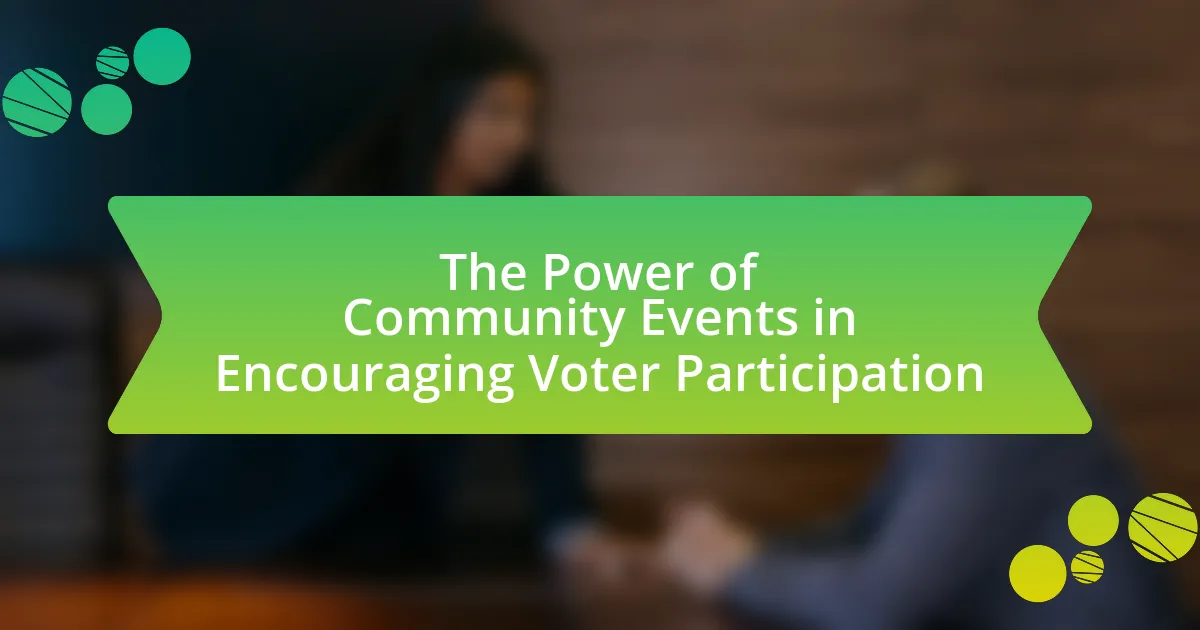Grassroots movements are organized efforts by ordinary individuals aimed at achieving social or political change, particularly at the community level. These movements play a vital role in mobilizing voters by enhancing community engagement, raising awareness of critical issues, and encouraging electoral participation. The article explores the differences between grassroots movements and traditional political campaigns, the strategies employed to engage voters, and the impact of these movements on voter turnout and public policy. Additionally, it addresses the challenges faced by grassroots organizations, the role of technology in their efforts, and best practices for sustaining voter engagement and support.

What are Grassroots Movements and Their Role in Mobilizing Voters?
Grassroots movements are organized efforts by ordinary people to effect social or political change, often at the community level. These movements play a crucial role in mobilizing voters by fostering community engagement, raising awareness about issues, and encouraging participation in the electoral process. For instance, the grassroots campaign for Barack Obama in 2008 utilized local volunteers to connect with voters, resulting in increased voter turnout, particularly among young and minority populations. This demonstrates that grassroots movements can effectively galvanize support and drive electoral participation, thereby influencing election outcomes.
How do Grassroots Movements differ from Traditional Political Campaigns?
Grassroots movements differ from traditional political campaigns primarily in their structure and approach to mobilization. Grassroots movements are typically community-driven, relying on local volunteers and small donations to build support from the ground up, while traditional political campaigns often depend on established party structures, larger financial contributions, and professional consultants to drive their efforts. For example, the 2016 Bernie Sanders campaign exemplified grassroots mobilization by emphasizing small donations and volunteer engagement, contrasting with the more top-down approach seen in Hillary Clinton’s campaign, which utilized extensive fundraising from wealthy donors and established political networks. This fundamental difference in mobilization strategies highlights how grassroots movements can effectively engage and energize voters by fostering a sense of community ownership and participation in the political process.
What strategies do Grassroots Movements employ to engage voters?
Grassroots movements employ strategies such as community organizing, door-to-door canvassing, social media engagement, and mobilizing local events to engage voters. Community organizing focuses on building relationships and networks within neighborhoods to foster collective action and awareness about issues. Door-to-door canvassing allows activists to have personal interactions with potential voters, providing them with information and encouraging them to participate in elections. Social media engagement leverages platforms like Facebook and Twitter to disseminate information rapidly and mobilize supporters, reaching a broader audience effectively. Local events, such as town halls and rallies, create opportunities for direct engagement, allowing voters to voice their concerns and connect with the movement’s goals. These strategies have been shown to increase voter turnout; for instance, a study by the National Bureau of Economic Research found that door-to-door canvassing can increase turnout by 7-10%.
How do Grassroots Movements build community support?
Grassroots movements build community support by fostering local engagement and mobilizing individuals around shared goals. These movements often utilize direct communication methods, such as community meetings and social media campaigns, to raise awareness and encourage participation. For example, the 2018 midterm elections in the United States saw grassroots organizations like Indivisible successfully mobilize voters by organizing local events and providing resources for civic engagement. This approach not only strengthens community ties but also empowers individuals to take action, leading to increased voter turnout and participation in the democratic process.
Why are Grassroots Movements crucial for voter mobilization?
Grassroots movements are crucial for voter mobilization because they engage communities at the local level, fostering a sense of ownership and empowerment among individuals. These movements utilize personal connections and localized strategies to encourage participation, which has been shown to increase voter turnout significantly. For instance, research by the Pew Research Center indicates that grassroots efforts can lead to a 10-20% increase in voter turnout compared to traditional campaigning methods. By focusing on the specific needs and concerns of the community, grassroots movements effectively mobilize voters who may otherwise feel disenfranchised or overlooked.
What impact do Grassroots Movements have on voter turnout?
Grassroots movements significantly increase voter turnout by mobilizing communities and fostering engagement. These movements often utilize local networks to educate voters about issues, thereby enhancing awareness and motivation to participate in elections. For instance, the 2018 midterm elections in the United States saw a notable increase in voter turnout, attributed in part to grassroots organizations like Indivisible and MoveOn, which registered millions of new voters and organized local events. Research indicates that areas with active grassroots campaigns experienced turnout rates as high as 50% compared to lower rates in regions without such initiatives, demonstrating the direct correlation between grassroots efforts and increased electoral participation.
How do Grassroots Movements influence public policy and political discourse?
Grassroots movements influence public policy and political discourse by mobilizing community members to advocate for specific issues, thereby shaping legislative agendas and public opinion. These movements often utilize social media and local organizing to raise awareness and build coalitions, which can lead to significant policy changes. For example, the Black Lives Matter movement has successfully brought issues of racial injustice and police reform to the forefront of national discourse, resulting in policy proposals and legislative actions in various states. Additionally, grassroots campaigns can pressure elected officials to respond to constituents’ needs, as seen in the Fight for $15 movement, which has led to increased minimum wage laws in several cities and states.
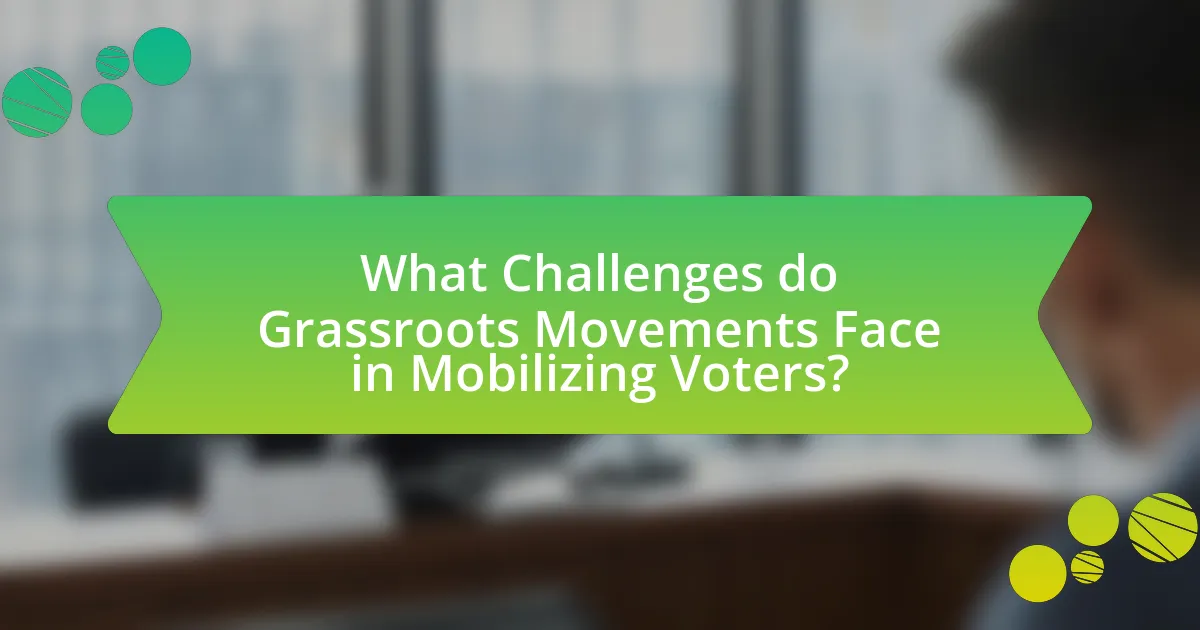
What Challenges do Grassroots Movements Face in Mobilizing Voters?
Grassroots movements face several challenges in mobilizing voters, including limited resources, lack of media coverage, and difficulties in reaching diverse populations. Limited financial and human resources hinder their ability to organize events, conduct outreach, and sustain campaigns effectively. Additionally, mainstream media often overlooks grassroots efforts, making it challenging for these movements to gain visibility and attract broader support. Furthermore, reaching diverse populations can be complicated by language barriers, cultural differences, and varying levels of political engagement, which can impede effective communication and mobilization strategies. These factors collectively restrict the overall impact of grassroots movements in voter mobilization efforts.
How do funding and resources affect Grassroots Movements?
Funding and resources significantly impact grassroots movements by determining their operational capacity and outreach effectiveness. Adequate funding allows grassroots organizations to hire staff, organize events, and utilize marketing strategies, which are essential for mobilizing voters. For instance, the 2018 midterm elections in the United States saw grassroots movements like Indivisible leverage substantial donations to coordinate local events and voter registration drives, resulting in increased voter turnout in key districts. Additionally, access to resources such as technology and training enhances the ability of grassroots movements to engage communities and disseminate information effectively, further amplifying their influence in the electoral process.
What are the common obstacles faced by Grassroots Movements?
Grassroots movements commonly face obstacles such as limited funding, lack of media coverage, and internal conflicts. Limited funding restricts their ability to organize events, reach wider audiences, and sustain long-term initiatives. For instance, a study by the National Democratic Institute found that financial constraints significantly hinder grassroots efforts in mobilizing voters. Lack of media coverage can prevent these movements from gaining visibility and support, as mainstream media often overlooks smaller initiatives in favor of larger organizations. Internal conflicts, including differing priorities among members, can lead to fragmentation and reduced effectiveness, as evidenced by various case studies on community organizing. These challenges collectively impede the ability of grassroots movements to effectively mobilize voters and influence political outcomes.
How can Grassroots Movements overcome these challenges?
Grassroots movements can overcome challenges by leveraging community engagement, utilizing social media for outreach, and forming coalitions with like-minded organizations. Community engagement fosters trust and mobilizes local support, as seen in the success of the Black Lives Matter movement, which effectively organized protests and discussions at the grassroots level. Social media platforms enable rapid dissemination of information and mobilization efforts, exemplified by the Women’s March, which utilized online tools to gather millions of participants globally. Additionally, forming coalitions amplifies resources and influence, as demonstrated by the collaboration between various environmental groups during the climate strikes, which significantly increased visibility and impact.
What role does technology play in Grassroots Movements?
Technology plays a crucial role in grassroots movements by facilitating communication, organization, and mobilization among supporters. It enables activists to quickly disseminate information, coordinate events, and engage with a wider audience through social media platforms, email campaigns, and mobile applications. For instance, the use of social media during the Arab Spring in 2011 exemplified how technology can amplify grassroots efforts, allowing for rapid mobilization and international awareness. Additionally, data analytics tools help grassroots organizations identify and target specific voter demographics, enhancing their outreach effectiveness. These technological advancements have transformed traditional grassroots strategies, making them more efficient and impactful in mobilizing voters.
How do social media platforms enhance voter mobilization efforts?
Social media platforms enhance voter mobilization efforts by providing targeted outreach, facilitating information sharing, and fostering community engagement. These platforms allow campaigns to identify and reach specific demographics through targeted advertisements, increasing the likelihood of voter participation. For instance, during the 2020 U.S. presidential election, social media was instrumental in mobilizing younger voters, with 50% of voters aged 18-29 reporting that they learned about candidates and issues through social media. Additionally, social media enables rapid dissemination of information regarding voting procedures, deadlines, and events, which is crucial for grassroots movements aiming to inform and engage potential voters. The ability to create and share content that resonates with local communities further strengthens these mobilization efforts, as seen in various successful campaigns that utilized platforms like Facebook and Twitter to organize events and encourage voter turnout.
What tools are most effective for Grassroots Movements in reaching voters?
Grassroots movements effectively reach voters through social media platforms, community organizing, and door-to-door canvassing. Social media allows for rapid dissemination of information and engagement with a broad audience, as evidenced by the 2016 U.S. presidential election where platforms like Facebook and Twitter played crucial roles in mobilizing young voters. Community organizing fosters local connections and builds trust, which is essential for voter turnout; studies show that personal interactions significantly increase the likelihood of individuals voting. Door-to-door canvassing has been shown to increase voter turnout by 7-10%, according to research from the University of California, Berkeley. These tools collectively enhance grassroots movements’ ability to engage and mobilize voters effectively.
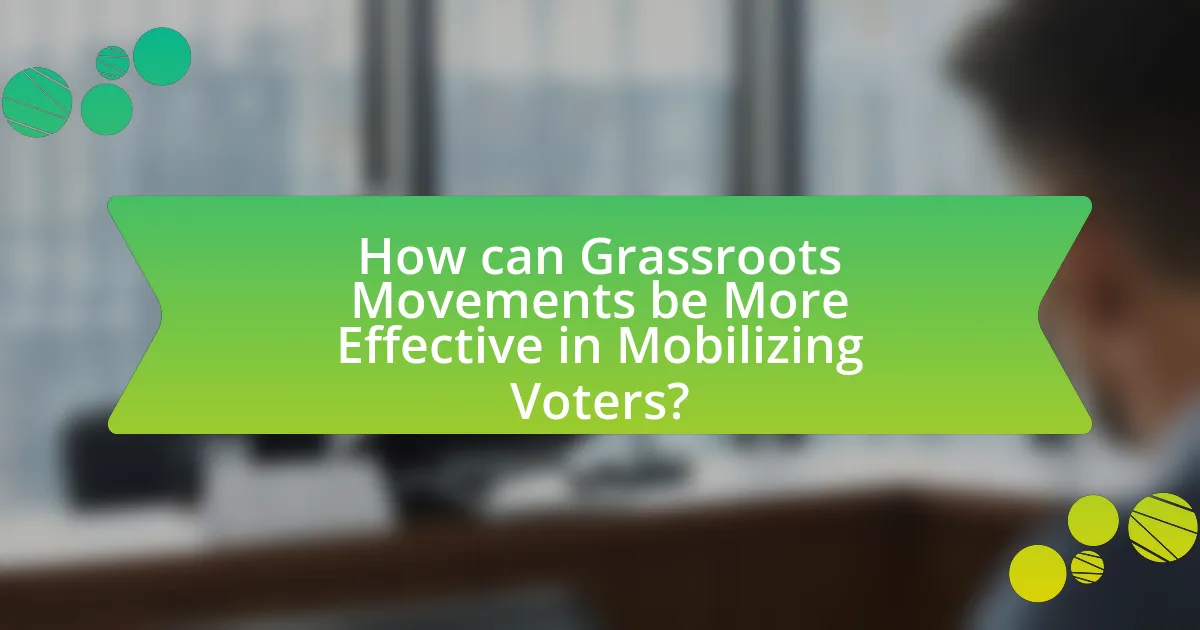
How can Grassroots Movements be More Effective in Mobilizing Voters?
Grassroots movements can be more effective in mobilizing voters by leveraging community engagement and utilizing targeted communication strategies. Engaging local communities fosters trust and encourages participation, as seen in the 2008 Obama campaign, which effectively used neighborhood canvassing to increase voter turnout by 5% in key demographics. Additionally, employing social media platforms allows grassroots movements to reach a broader audience quickly, as evidenced by the viral success of the #BlackLivesMatter movement, which mobilized millions for voter registration and participation. By focusing on these strategies, grassroots movements can enhance their effectiveness in mobilizing voters.
What best practices should Grassroots Movements adopt?
Grassroots movements should adopt clear communication strategies to effectively mobilize voters. Clear messaging helps to articulate goals and rally support, as evidenced by the success of movements like the Women’s March, which utilized social media to reach millions and convey a unified message. Additionally, grassroots movements should prioritize community engagement by organizing local events and forums, fostering relationships that encourage participation. Research shows that personal connections significantly increase voter turnout, as seen in the 2018 midterm elections where local outreach efforts led to a 50% increase in voter participation in targeted areas. Finally, leveraging data analytics to identify and reach potential supporters can enhance campaign effectiveness, as demonstrated by the Obama campaign in 2008, which utilized data-driven strategies to mobilize voters efficiently.
How can Grassroots Movements effectively engage diverse communities?
Grassroots movements can effectively engage diverse communities by employing inclusive strategies that prioritize representation and local needs. These movements often utilize community organizing techniques, such as door-to-door outreach and local events, to build trust and foster relationships with various demographic groups. For instance, the 2018 midterm elections saw organizations like Indivisible successfully mobilize diverse voter bases by tailoring their messaging to resonate with specific communities, addressing issues such as healthcare and immigration that directly impact them. This approach not only increases participation but also empowers individuals by giving them a voice in the political process, as evidenced by the significant voter turnout among historically underrepresented groups during these elections.
What methods can Grassroots Movements use to sustain voter engagement?
Grassroots movements can sustain voter engagement through consistent communication, community-building activities, and leveraging social media platforms. Consistent communication keeps voters informed about issues and mobilizes them for action, as evidenced by the success of organizations like MoveOn, which utilizes email campaigns to maintain contact with millions of supporters. Community-building activities, such as local events and town halls, foster a sense of belonging and encourage participation, demonstrated by the effectiveness of grassroots campaigns in increasing voter turnout in local elections. Additionally, leveraging social media platforms allows grassroots movements to reach wider audiences quickly and engage younger voters, as seen in the 2018 midterm elections where social media campaigns significantly increased voter participation among millennials.
What lessons can be learned from successful Grassroots Movements?
Successful grassroots movements demonstrate the importance of community engagement and collective action in driving social change. These movements often rely on local leaders who understand the specific needs and concerns of their communities, which fosters trust and encourages participation. For example, the Civil Rights Movement in the United States effectively mobilized citizens through grassroots organizing, leading to significant legislative changes such as the Civil Rights Act of 1964. Additionally, successful grassroots movements utilize clear messaging and inclusive strategies to broaden their appeal, as seen in the Women’s March, which united diverse groups around common goals. These lessons highlight that effective grassroots movements prioritize local involvement, clear communication, and inclusivity to mobilize voters and achieve their objectives.
Which case studies exemplify effective voter mobilization through Grassroots Movements?
Case studies that exemplify effective voter mobilization through grassroots movements include the 2008 Obama campaign and the 2016 Bernie Sanders campaign. The Obama campaign utilized a robust grassroots strategy that involved community organizing, door-to-door canvassing, and leveraging social media to engage young voters, resulting in a record turnout of 69.5% of eligible voters. Similarly, the Sanders campaign in 2016 mobilized a large base of volunteers who organized rallies and utilized social media to reach voters, particularly younger demographics, contributing to a significant increase in voter participation in the primaries. Both cases demonstrate how grassroots movements can effectively mobilize voters by fostering community engagement and utilizing innovative outreach strategies.
What key takeaways can be applied to future Grassroots efforts?
Key takeaways for future grassroots efforts include the importance of community engagement, effective communication strategies, and leveraging social media platforms. Community engagement fosters trust and builds a strong support base, as evidenced by the success of movements like the 2018 March for Our Lives, which mobilized thousands through local organizing. Effective communication strategies, such as clear messaging and storytelling, enhance relatability and inspire action, demonstrated by the success of the Black Lives Matter movement in raising awareness and driving participation. Additionally, leveraging social media platforms allows for rapid dissemination of information and mobilization, as seen in the viral campaigns of various grassroots initiatives. These elements are crucial for maximizing impact and ensuring sustained momentum in future grassroots efforts.
What practical steps can individuals take to support Grassroots Movements?
Individuals can support grassroots movements by actively participating in local initiatives, volunteering time, and donating resources. Engaging in community events, attending meetings, and spreading awareness through social media amplifies the movement’s message. Research indicates that grassroots movements significantly increase voter turnout; for example, the 2018 midterm elections saw a 50% increase in voter participation attributed to grassroots efforts. By contributing to these initiatives, individuals help create a more informed and engaged electorate, ultimately strengthening democratic processes.
